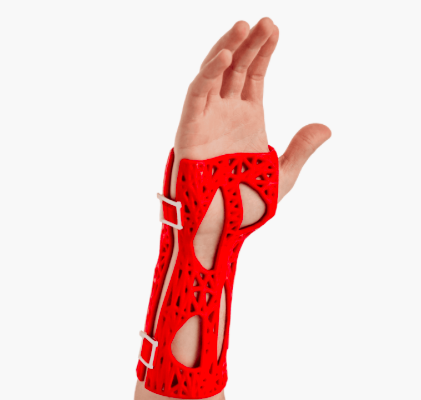Using a supercomputer in medical equipment production is almost by 25% more efficient
21st-century treatment – a fixator made of environmentally friendly biologically degraded plastic Ltd. “Castprint”. Thanks to the financial support of the European Commission within the FF4EuroHPC, Ltd. “Castprint” introduced the capabilities provided by a supercomputer or High-Performance Computing (HPC) in their production process, making it 25 % more efficient.
“Here at the HPC Competence Center in Latvia, we see that entrepreneurs in Latvia are looking for ways to improve production processes. For many of them, using an HPC would be very helpful. Collaboration with Ltd. “Castprint” is a great example that shows how our HPC Competence Center can help – we provide consultations and help to find appropriate experts if they are needed in order to introduce digital solutions on a supercomputer and increase competition not only locally, but also in the international market.” says Dr. Phys. Janis Virbulis, Head of the Laboratory of Semiconductor Technologies at the Institute of Numerical Modelling, University of Latvia (LU).
Briefly about the project
Ltd. “Castprint”, the LU Institute of Numerical Modelling, and Riga Technical University’s (RTU) HPC Center realized the Ortho HPC project with overall funding 140 thousand euros received from the FF4EuroHPC.
Project duration: 01.03.2022. – 31.05.2023. (15 months).
Purpose of the project: to include a supercomputer calculation in Ltd.“Castprint’s” production cycle to improve the quality of a personalized medical assistive device (fixator) made by a 3D printer, and reduce production costs.
The main challenge of Ltd. “Castprint” was to ensure that the fixator models created with a supercomputer and the printed material itself would meet the high requirements of patients and doctors and the production quality.
The role of LU Institute of Numerical Modelling in the project was to create a numerical model and topological optimization algorithms, as well as organizing the durability assessment of the newly developed product.
The role of RTU HPC Center as the largest HPC resource provider in Latvia was to support with the knowledge about the necessary technical and software provisions for the successful implementation of the project.
How did the idea of replacing the gyps with a fixator start?
When a fracture occurs, it requires immediate medical assistance. Most often, people get the first medical aid from professionals who use the well-known gyps material. Those with a fracture will probably know that after walking with gypsum for a long time, the skin underneath is itching and sweating, it does not breathe. In case of minor fractures, Ltd. “Castprint” offers an alternative – to use a medical device or fixator instead of gypsum (seven to 14 days after the gypsum or as recommended by a doctor). The fixator is lighter and more breathable than gypsum.
There are many challenges in the production of fixators. The most important ones – how to shorten production time? how to reduce manual steps? how to save 3D printing times? During the Ortho HPC project, these challenges also had a solution: parametric model optimization and HPC technology.
Among the different types of fractures and fixators, the first ones that were selected for introducing the HPC technology in the manufacturing process, were handheld fixators, because hand palms are among the most common fractures.
Main benefits from using a supercomputer in the production process
- The time from making an order and starting to use a fixator has been reduced by 25%.
- Production costs decrease up to 15%.
- The production capacity with using an HPC on the existing company resources increases up to 25%.
- Since the introduction of HPC technology, the final price of the product can be reduced by up to 15 % (patients have the opportunity to spend less money).
- It is possible to increase the availability of the latch.
- Possibility to increase export.
- Ltd. “Castprint” uses plastic in the manufacture of fixators, however it is pleasing to see that plastic consumption can be reduced by up to 25% if HPC is used in the production process.
- The reduced printing time also creates the ability to reduce electricity energy consumption by up to 25 %.
More information on FF4EUROHPC is available here.
More information on Ltd. “Castprint” is available here.
To apply for a consultation at the HPC Competence Center in Latvia here.
The material was prepared by Kintija Bulava, EuroCC 2 Latvia.




